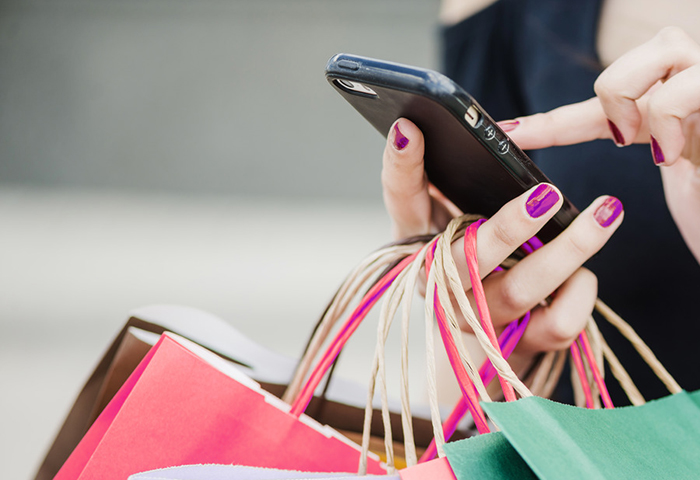Conclusions about the future of retail after the “Black Friday”

Black Friday for online retail has been very productive.
Nostalgia still led consumers to regular stores. But not for great offers, but more for the unique atmosphere of discounts and festive mood, which can only be truly felt in the magnificently decorated malls.
But this year, millions of people left the car in the garage and took advantage of profitable promotions without getting up from the couch. Adobe analyzed 80 of the 100 most popular online retailers and found out that between Thanksgiving and the end of Black Friday, consumers made purchases worth $ 2 billion from their smartphones.
')
With any other day for shopping, “Black Friday” is united by the fact that the majority of consumers, as usual, were in search of lucrative offers and convenient consumer experience, for which they actively used smartphones.
Shopping at your fingertips
According to a study conducted in 2016, people take a smartphone in their hands 2617 times a day, that is, almost every 33 seconds.
Then this statistic seemed amazing. Now it is not only quite plausible, but also indicates the importance of mobile devices in solving everyday user tasks. Smartphones have become a catalyst that every 33 seconds speeds up the blurring of the line between online and offline worlds for both consumers and businesses.
The impact of mobile devices is most strongly felt in the process of searching and buying the desired goods. The second annual study of the analytical group PYMNTS, conducted jointly with Visa, allows us to appreciate the speed and enthusiasm with which consumers let in their lives new Internet devices and scenarios that make shopping more contextual.
Voice devices are becoming more popular. The number of purchases made with their help has increased significantly over the past 12 months. Today, 28% of all American consumers own such devices, and 27% of them told researchers that they had made at least one purchase using voice control. The prosperity of such devices and related applications will lead to an even greater shift of commerce in the online direction.
A wide choice of Internet devices provides merchants with an unprecedented opportunity to search for users and turn them into consumers whenever people are in the mood to make a purchase. And regardless of where they are at the moment.
According to Adobe, 49% of online traffic on Black Friday is generated by smartphones. Almost a third (30%) of all purchases were made from them.
Devices radically changed the consumer approach to physical shopping.
Find to buy
In September 2018, PYMNTS analysts conducted a survey among 4900 consumers, studying exactly how people buy from smartphones what was once available only in physical stores. They asked respondents to describe the last purchase made in the previous 24 hours. The survey was conducted over seven days to tie the answers to the days of the week.
The result was the fact that most retailers probably installed on their own: consumers visit the store not at all for the surprise and delight of the new products that await them upon arrival. In reality, it is quite the opposite. Today, visits to physical stores are associated with the desire to make sure that the right product is available, and the consumer can go home with him in his hands.
Spiral of death of physical retail, double two
In 2014, the PYMNTS blog published an article about the upcoming extinction of physical retail. Then there was an obvious tendency to decrease in attendance at malls during the Christmas season, since it was the fourth year of a noticeable drop in performance. This change was observed not only statistically, but also in the real world: it was enough to come to any of the shopping centers and see how few visitors there were.
Some analysts attributed this decline to cautious savings. The consequences of the financial crisis were affected. And, according to experts, consumers often used smartphones and laptops to search for lucrative offers in order to better control their spending.
At the same time, everyone believed that physical retail would remain relevant and continue to dominate in conjunction with other retail channels. In the end, 95% of all sales still occurred in physical stores.
And now, four years later - the economic growth and consumers who regularly buy, filling their baskets to the top, because they are confident in their profits and earnings prospects.
At the same time, quite recently the publication The Wall Street Journal reported that attendance at physical stores continued to fall for the fourth year in a row, though not as rapidly as it was before, and not only during the Christmas holidays, but in general. This decline occurs even against the backdrop of a strong economy and in a consumer boom that has not been observed for several years.

Source: RetailNext
More than 83% of PYMNTS respondents visit stores not to search for new products, but to buy things that they have checked for in advance using smartphones. According to PYMNTS, only 16.5% of US consumers today use physical stores to search for desired goods, although ten years ago this figure was 100%.
Consumers increasingly come to the store with a clear understanding of exactly what they want to buy and how much it will cost. Or even take the already paid order.
About 79% of PYMNTS respondents were shopping at physical stores over the weekend, including categories such as food and groceries.
And 22% of research participants made purchases online and did it in various product segments: they bought clothes and accessories, as well as (to a lesser extent) groceries and left pre-orders at fast-food restaurants.
The results were obtained during the most ordinary, unremarkable fall week.
About a quarter of online shoppers from the study made purchases in excess of $ 100. Women accounted for 59% of respondents using smartphones for shopping. More than a third (36%) buy with debit cards, 28% with credit cards and 11% with PayPal.
Sixty-one percent of respondents expressed satisfaction with their purchases.
The only channel that managed to surpass smartphones is personal computers. In this segment, the rate of satisfaction with purchases was 65%.
As for shopping in physical stores, it was in third place with 58%.
Physical retail ship is sinking.
New reality of retail
Consumers, accustomed to the fast pace of modern urban life, value their time more than ever. They view mobile and other Internet devices as effective tools that allow you to shop regardless of location: from home or office, on the way to work and even on vacation with friends.
As a result, convenience, which is valued by consumers above all, turns into a business card of a new, modern retail. And this pattern is valid for all types of purchases.
Sixty-one percent of consumers surveyed by PYMNTS, last bought a piece of clothing found online, and 42% of them bought it there. More than half (51.5%) of the respondents bought the last mass-produced goods online as well, 39% of them registered its online purchase. Those who completed the purchase in a physical store, first found out online what they need and where they need to come for the best price.
According to the available information, high attendance of physical stores was observed in the mornings, when the most profitable and widely advertised offers operated there. And at other times of the day the flow of customers was low. Smartphones also opened access to information about these sales, as a result of which buyers can now use the list of stores with favorable prices in certain categories.
While this approach is relevant, if the consumer needs to receive the goods as soon as possible. However, thanks to logistics, this process will soon become democratic, and people will be able to receive the ordered goods on the same day. As a result, the need to visit physical stores will be even less.
That is why “Black Friday” is just a slightly more improved version of modern search and purchase of goods. Now consumers do not need to go to the store to find great deals. No need to get up early to take a place in the queue, or swear at the parking space in the mall, in order to eventually get the desired product. You only need to get the smartphone every 33 seconds, check notifications about promotions, view email and click on "Buy".

Source: https://habr.com/ru/post/432152/
All Articles